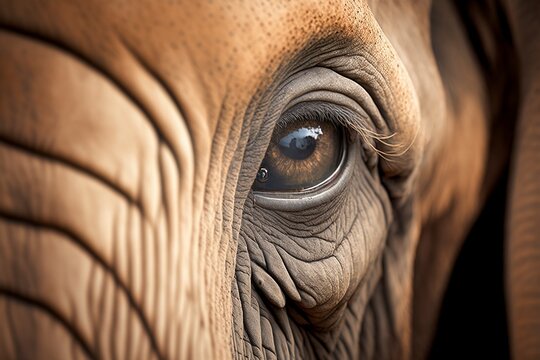Elephants are majestic creatures, and their eyes are a window into their gentle souls. But what color are these eyes that observe the world with such wisdom?
Elephants’ eyes are typically a deep, rich brown, often appearing almost black from a distance. This coloration helps them to blend in with their natural surroundings and plays a crucial role in their survival. Have you ever peered into the eyes of an elephant and wondered about their hue?
It’s a detail that’s both intriguing and telling of these magnificent animals. Their eyesight may not be their strongest sense, but the color of an elephant’s eyes is more than just a trait; it’s a part of their identity in the wild. This introduction will guide you through the fascinating aspects of elephant eyes, their color, and what it means for these giants of the savannah. By understanding the color of elephants’ eyes, we gain insight into their lives and the adaptations they have made to their environment. Join us as we delve into the intriguing world of elephants and discover the secrets behind the color of their captivating eyes.
The Enigma Of Elephant Eyes
Elephant eyes are small compared to their huge size. Their color is often a deep brown. These large animals have long lashes. The lashes protect their eyes from dirt and sun. Elephants have a special third eyelid. This eyelid cleans and keeps the eye moist.
Elephant eyes are set on the sides of their head. This gives them a wide view to spot danger. They can see well in the daytime. At night, their vision is not as good. Their eyes adapt to different levels of light. This helps them survive in various environments.
Colors In The Animal Kingdom
Elephant eyes are unique in color. They may appear small but serve a big purpose. Like other animals, elephant eyesight is vital. It helps them find food and stay safe from predators.
Coloration in animals is not just for beauty. It can mean camouflage, communication, or mate attraction. For elephants, eye color is part of their survival tools.
Let’s look at elephant eyes and compare them. We see they are different from other species. Many animals have eyes that shine in the dark. Elephant eyes are less shiny. This helps them in the wild.
Some creatures have colorful eyes. Think of peacocks or butterflies. Their colors are bright and varied. Elephant eyes are more subtle. They blend with their surroundings.
Investigating Elephant Eye Color
Elephants have big eyes. Many people think their eyes are black. Research tells us more. Scientists looked very close. They found out elephants have dark brown eyes. Not black. This is a fact. Some myths say elephants have magical eye colors. That’s not true. Their eyes help them see at night. This is important for finding food. Their eye color is beautiful and natural. It’s all about how they live. Their eyes tell a story of survival. Remember, elephants’ eyes are dark brown. Not black. This is what science says.

Credit: stock.adobe.com
Implications Of Eye Color On Elephant Behavior
Elephants have eyes that may seem small. But their color is key. Eyes can be brown or blue. This color helps them see and live with others.
Eye color matters for elephants. It can change how they act. Brown eyes are common. They blend in. This helps them hide from danger.
Blue eyes are rare. They are not common in wild elephants. But they can see well at night. This helps them stay safe from predators.

Credit: globalelephants.org
Conclusion
Elephant eyes are a wonder of nature, often overlooked. They carry a hue that’s subtle yet significant in the animal kingdom. Discovering their color offers us a glimpse into their world. So, they’re not just big and grey; their eyes tell a story too.
This post shed light on that, revealing the mystery behind elephant eyes. Now you know the answer and can share this fun fact. Remember, every detail in nature has its own charm. Let’s appreciate these gentle giants and the beauty they hold in their eyes.
Keep exploring and stay curious about the wonders of wildlife!








